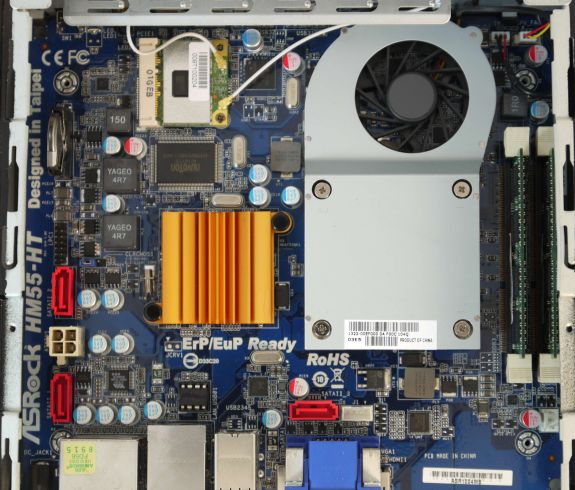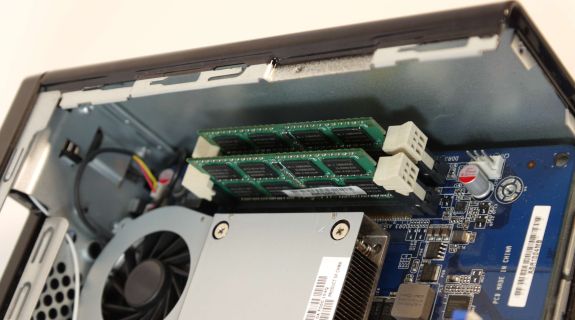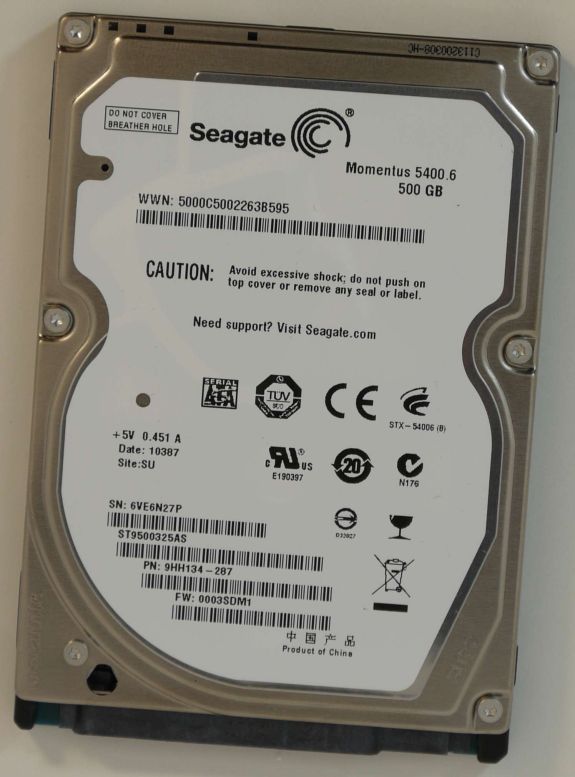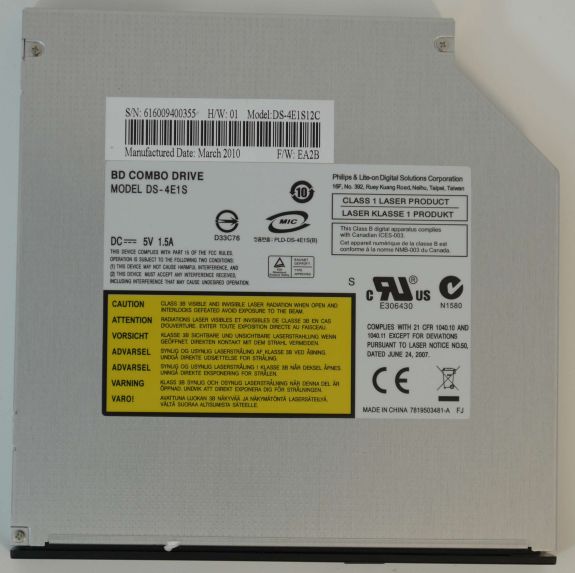ASRock Core 100HT-BD : Bringing HTPCs to the Mainstream Market [UPDATED : Noise Issue]
by Ganesh T S on July 19, 2010 9:34 PM EST- Posted in
- Home Theater
- Arrandale
- ASRock
- Media Streamer
- Core i3
- HTPC
Analyzing the system specifications reveals one clear advantage for ASRock. It is not going to be possible for the average HTPC enthusiast to build a similar system himself with off-the-shelf components. The reason lies in the fact that the Arrandale processor used in the system is currently available for OEM purchase only. All the processors available for general purpose (the Clarkdales) do not fit in the same power envelop as the Arrandales. We covered the Arrandale platform in detail earlier, and concluded that it had a very good power consumption / performance balance. In this section, we will analyze each of the system components in detail.
Motherboard & Chipset: mini-ITX Mobile Intel H55 Express
Over the last 6 months, we have seen many motherboards featuring the H55 chipset. In the mini-ITX form factor, we have covered Zotac's offering as well as Gigabyte's. However, both of them are meant for the desktop Clarkdale processors. What we see in the Core 100 HT-BD is more similar to the motherboards one sees in notebooks. Feature wise, the ASRock motherboard can be compared with the Gigabyte version, since both have support for USB 3.0 ports. However, being a mobile platform, there are some important differences. Tagging on USB 3.0 ports to the HM55 chipset is fraught with issues (more on this in the Performance section). Also, there is no PCI-E x16 slot in the motherboard because the chipset doesn't support it. DVI and PS2 ports are also absent. However, compared to the Gigabyte board, we have two extra USB 2.0 ports. The odd thing to observe here is that ASRock has decided to go with a VGA port instead of DVI, and providing us with a HDMI to DVI adapter, instead of providing a DVI port with a DVI to VGA adapter for folks with older equipment.
Rounding up the other components of the motherboard, we have the Realtek RTL8111E for GbE, and the VIA VT2020 for audio. The mini PCI-E expansion slot is occupied by the Atheros AR9287 module capable of 300 Mbps. As can be seen from the photograph, we have wires connected to the side panels, which act as antennae for the wireless signals. Like many other offerings in the market, ASRock also uses NEC's USB3 controller, giving the system two USB 3.0 ports. Another interesting chip on the board is the Nuvoton NCT6775F. It handles all the sensors (fan speed, temperature etc.) and also the IR support for the MCE remote.
The H55M chipset supports upto 4 SATA ports. In the Core 100 HT-BD, two of them are used by the Blu Ray drive and the hard disk. One of them is free for use by an optional 2nd hard drive (or SSD). The last one is made available as an eSATA port on the back panel. The mini-PCIE slot, as already mentioned, is taken up by the wireless module. In essence, the Core 100-HT BD's motherboard is a notebook motherboard in the mini-ITX form factor.
The Gigabyte mini-ITX (based on the H55) with the USB 3.0 ports can be purchased from Newegg currently for around $100. Since ASRock's version is based on the mobile version of the chipset, and also has a THX certified audio codec chip, the cost is bound to be slightly higher. One must also take into consideration the cost of the Atheros AR9287, which can be bought for around US $15 online. For the purpose of cost analysis, let us assume that one may theoretically be able to purchase a similar motherboard for US $140.
CPU & GPU: Intel Core i3-330M @ 2.13 GHz, iGPU @ 667 MHz
For the form factor and thermal design of the Core 100 HT-BD, only processors with a maximum TDP of 35W are supported. Also, most HTPCs do not require features like Turbo Boost, particularly when their performance exceeds what people have come to expect out of a particular form factor (talking about the Atom nettops) by a magnitude. Keeping in mind the cost of the processors and the nett cost of the system, ASRock has decided to go with the lowest end of the Arrandale spectrum, namely, the Core i3-330M. We feel that this is a very good choice, as the processor is powerful enought for most of today's demanding tasks, particularly from a HTPC perspective.
The integrated GPU is clocked at 600 MHz by default in the system, but it can be easily overclocked to 900 MHz without much effect on fan noise or any concerns about the system heating up. Most HTPC users are more interested in turning down the heat and power consumption. Towards this, attempts are made to undervolt or underclock the CPU. In our opinion, for the Core 100 HT-BD, the savings obtained through these methods are not worth the trouble. Intel's SpeedStep technology is enabled on this system, and we observed that the cores would clock around 940 MHz when doing light browsing tasks, and kick upto 2.14 GHz under heavy load. It is easy to overclock the system too (from within Windows, as well as the BIOS), but the need would probably be never felt in a HTPC usage scenario.
The pricing of the Core i3-330M is available only to OEMs. Our sources, however, informed us that it costs around US $135 in high volume.
DRAM: Elixir Memory's 2 x 2GB Nanya DDR3 @ 1066 MHz
The Core 100 HT-BD has two DDR3 slots, both of which are occupied by the 2 GB Nanya DIMMs. One can potentially use 4 GB DIMMs to get 8GB of system memory, but that would be an overkill from the HTPC perspective. ASRock's choice of 4GB is more than enough for the HTPC.
The 2 DIMMs can be bought currently for around $100 in total from resellers in the US.
Hard Disk: Seagate Momentus 2.5" 5400 rpm 500 GB
Since the form factor of the build indicates that the system is more of a notebook, the hard drive inside is a 2.5" model. ASRock has gone in with the Seagate Momentus 5400 rpm drive. While one might prefer a faster drive for installing the OS, there is no doubt that the lower power consumption of this unit makes it an ideal choice for the HTPC. There is enough space inside the system for an additional 2.5" drive, and filling that up with a SSD would be a great choice for the boot drive. The shipped Seagate drive is ideal and capacious enough for HTPC duties.
The hard drive can be currently had from Newegg for US $65.
Optical Disk Drive: Philips / Lite-On Blu-Ray / DVD RW
The Core 100 HT-BD model ships with the Lite-On DS-4E1S Blu-Ray / DVD RW drive. Again, this is a model meant for notebooks, with the tray not coming out fully when ejected. It can be found online for around $90 without shipping charges taken into consideration.
Miscellaneous Components
The chassis is obviously custom made for this motherboard. ASRock also throws in the SATA, power cables and screws for the optional 2nd hard drive. Mini-ITX cases with PSUs of much higher rating (the unit comes with an external 90W adapter) can be had for around US $50. So, we estimate the cost of the chassis, power adapter and other similar accessories to be around the same. Note that the unit also ships with an IR based MCE remote. Though the build quality of the remote is not high end in nature, we estimate that it adds around $30 to the cost.
Cost Analysis
| ASRock Core 100HT-BD Pricing Analysis | ||||
| Component | Average Price Online | |||
| Motherboard (with mini-PCIe wireless) | $140 | |||
| CPU | $135 | |||
| DRAM | $100 | |||
| HDD | $65 | |||
| Optical Drive | $90 | |||
| MCE Remote & IR Receiver | $30 | |||
| Misc Components (Chassis, Power Adapter, Cables, etc...) | $50 | |||
| Total Cost to Build | $610 | |||
| ASRock Core 100HT-BD Estimated Cost | $700 | |||
Newegg is supposed to have this HTPC for sale soon around the $700 price point. (The model with the DVD drive instead of the Blu-Ray is already on sale for $650.) With only a $90 premium over a home built HTPC, this is not a bad investment from the value viewpoint. Do note that the cost of the OS and keyboard / mouse have to be added on to this to get a sense of the true cost of the system. Also, we still have to take a look at the unit from various other perspectives. Read on to find out more.














107 Comments
View All Comments
ganeshts - Tuesday, July 20, 2010 - link
Aikouka,Thanks for your insights.
1. Customers should hopefully be able to salvage some stuff from their previous setups (Blu-Ray playback software, keyboards and mice etc.)
2. We didn't do exhaustive testing on the VIA codec. Most of the time, it was disabled since we were using audio over HDMI.
3. The sticker is optional ( It comes as a separate label with the package, but you can choose whether to stick it in the front or not :) )
4. The build quality of the remote is not that great and there are better options out there as you observe.
5. Major drawback of ION is the lower general performance, higher power consumption and absence of HD audio bitstreaming. I think the $200 extra is worth it.
Aikouka - Tuesday, July 20, 2010 - link
1) It'd definitely be nice to harvest a few extra items from previous builds, but maybe a blurb about the overall cost of the software might be nice. I'm not sure, but it might help people sway toward or against the unit as being their Blu-Ray player, since you can easily just buy a decent separate unit for $100 or so. Another aspect that might sway some users is that the BR software will only truly integrate into WMC (last I checked). TMT3 has a plug-in for MediaPortal, but it isn't true integration (just loads the player and minimizes MP).I guess that all kind of goes with your talk on how it can be a pain to get all of the formats working, which let me tell you... I definitely agree with you on that! I had a point where using my laptop as a HTPC, I could get sound while playing MKVs through WMP, but not with WMC. It was the strangest thing :P.
3) Alright, that's good that the sticker is optional ;). I just wish manufacturers would push to not showing the rest of those connectors. It seems the consumer's desire is to have components that are PCs that don't look like PCs, but not many devices have those connections and if they do, they're typically hidden (except the PS3, but they're out of the way).
5) I think the main point I was trying to drive is that even though the ION is inherently weaker, does it still perform the tasks properly? I mean, you can take the kids to school in a Porsche 911 Turbo, but is it a tad bit overkill compared to a Prius? Do you really think the bitstreaming matters that much? I don't think most people would even be able to tell the difference between a good encode output from a SPU and the bitstream... I know I can't! :)
------------------
I like the articles though... I think the HTPCs are going to become more and more popular as people look for non-standard ways to get content. I've actually gone back to using my server as a quasi-HTPC to help alleviate the stress I was putting on my M1530. It's a little better now that I replaced some of its noisy components :).
vlado08 - Thursday, July 22, 2010 - link
" 5. Major drawback of ION is the lower general performance, higher power consumption and absence of HD audio bitstreaming. I think the $200 extra is worth it. "And what about picture quality? HQV v 2.0
The ION does the 23,976 but the Core 100HT - does not.
ganeshts - Thursday, July 22, 2010 - link
Good point, vlad08. The point mentioned was the drawbacks of the ION. Of course, if one wants to give the advantages of ION, they are as you mention.I think the average users just set the display refresh rate to 60 Hz and forget about it.. so the 24fps bug doesn't affect those.
Picture quality.. yes, maybe ION is better. We haven't done benchmarking on that platform yet (and will probably not do because it is a product from last year, and we have more exciting Nvidia stuff coming up) to confirm.
pirspilane - Tuesday, July 20, 2010 - link
Good point about the software costs. This is really a $900+ machine.The Mac Mini competes well with this machine when you consider:
- It comes loaded with some very nice software
- It's light years ahead, aesthetically
- It beats the AsRock on noise and power consumption
- Most people already have a Blu-ray player and don't want the aggravation of dealing with Blu-ray playback on an HTPC. I rarely use my HTPC (Corel WinDVD) to play Blu-rays because of the hassle factor.
tmservo - Tuesday, July 20, 2010 - link
While this seems like a good train of thought, it isn't. The poster above points out he uses pro (which is fine, I do too) but there is no reason why Home Premium, which has media center, wouldn't be used by the majority of users. So, $645 + $91. That's it, for anyone wanting the DVD model. Or, about $736.Your comparison at $900 is based on a comparison with a model featuring a Bluray Drive and Bluray software. This is not valid, because you're now comparing apples to oranges ;) The mac mini doesn't have, won't have, and doesn't support a bluray drive. So, the two aren't the same, at all. There just isn't a comparison.
Whether or not people have a seperate player already, there are lots of people who like the idea of 1 single box doing everything, like DVR, DVD, BD, Media Management, etc.
So, let's say you do a comparison on that front. So, the Mac Mini is $699. DVD only. Yes, it comes with software, but not really a front end for this.. so you download Front Row, which was last updated almost 2 years ago. You then go about hacking it to get your supports you need.
And you add a remote control, because the Mac Mini doesn't come with one. So, even if this remote is "flimsly and crap" you add a remote control that is say $50 (and don't say "iPhone" because then you're adding $300 in expense for a remote for everyone who doesn't have one).
So now the cost of your Mini with a remote is basically the same as this with a copy of Win7HP. Except, oh yeah, even if you get the DVD one of this, your ability to later convert to BD is there. Not at all on the other front. Remote wakeup? Yep. Since neither have tuner slots, both would be using say a network tuner. So, Silicon Dust HDHomeRun for both. So a wash on the cost here, except Front Row can't natively manage those tuners for anything, meanwhile Media center can.
You can buy software to do that on the mac.. now you've spent more money.
The Mac Mini is a good unit as a desktop. But for an HTPC, you spend a lot of money for almost no bang. You can get an ION based unit at about $350 that is DVD based that gives you the exact same features.... plus LPCM for your MKVs that the Mini doesn't do worth a damn.
Nothing against the Mac, but not every purpose works out for it. This just isn't one where you say "wow is that a great solution for a Mac". And AppleTV is a laughable product that should die a slow death.
Guspaz - Tuesday, July 20, 2010 - link
One reason that ASU *cough* I mean ASRock is always the first to put these out is probably that all of their SFF machines use the exact same case, nearly the same packaging, and mostly the same pack-in material.They've used this exact same case all the way back to their first Atom machines. Their ION machines also used this case, as did their bluray machines.
Now that they've introduced some CULV machines, surprise, same case again.
kwrzesien - Tuesday, July 20, 2010 - link
True.And why is it narrow and tall? Why can't they put this in a DVD-sized case with the industry standard width? The front should look just as clean as a nice DVD player, with the front ports, buttons and maybe even the drive behind a fold-down door.
whartsell - Tuesday, July 20, 2010 - link
"Unfortunately, there is no single unified interface (from XBMC or MediaPortal or any other similar program) which could successfully play back all the files from within. "Cant SageTV play back all the tested formats?
dukero - Tuesday, July 20, 2010 - link
I wish I seen this coming last month Just about finished building one ECS itx mobo and i core 3 530 in jetway 101 case and mines going to end up at about grand after software and tuners. And as far as tuners go for the asrock get a USB or homerun Ethernet.